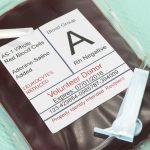Cardiac Biomarkers: A Well-Validated Clinical Tool
Student Scholarship Honorable Mention
Jocelyn Faydenko
Fraser Smith, MATD, ND
Cardiovascular disease (CVD) is the leading cause of mortality in the United States.1 Although the classic lipid panel presents well-validated information about long-term risk, it does not provide insight into the degree of inflammation within the arterial intima. Since atherosclerosis is an inflammatory disease, it is critical for prevention-oriented physicians to obtain information about the state of arterial inflammation and stability of focal plaques in their patients.2 Naturopathic medicine is a primary-care system of medicine with a strong emphasis on prevention and support of the body’s intrinsic healing pathways, often involving nutrition. By understanding how inflammatory biomarkers are indicative of cardiovascular risk, healthcare practitioners can better inform their patients of the potential risks they may face, as well as prevent cardiac events from occurring.3 The purpose of this review is to describe the predictive benefits of several key cardiac biomarkers, based on current evidence. It should be clear that these are of high relevance in the diagnosis and management of CVD, in both its incipient and progressive phases.
The use of advanced cardiac biomarkers is an emerging yet well-validated clinical tool that may be a better predictor of short-term risk than the classic lipid panel.3 Half of all patients who have experienced a cardiac event had cholesterol levels consistent with proper guidelines at the time.4 Unlike the traditional lipid panel, cardiac biomarker testing provides information about inflammation, including oxidative stress within the endothelium, oxidized LDL (OxLDL) cholesterol, C-reactive protein (CRP), and plaque (atherosclerotic) growth and stability. As evidenced in the JUPITER trial, statin drugs such as rosuvastatin lower CRP; thus, this anti-inflammatory effect may be as important as their total effect on circulating lipid levels.5
Biomarkers of Inflammation
F2-Isoprostanes
F2-Isoprostanes (IsoPs) are a measure of lipid peroxidation due to the metabolism of arachidonic acid, a compound necessary for mediating basic bodily functions, such as building muscle tissue. This marker has been utilized as one of the most sensitive indicators for lipid peroxidation in vivo, which led to its incorporation into a number of clinical trials.6 IsoPs have since become recognized as one of the most reliable biomarkers for lipid peroxidation and how it corresponds to disease. Several studies7-9 have found correlations between IsoP levels and both CRP and homocysteine levels. IsoPs have also been shown to be increased in individuals with hypertension as compared with normotensive individuals.10-13 In addition, healthy older adults were found to have significantly elevated IsoPs when subjected to short durations of ischemia/reperfusion, as compared with young adults exposed to the same conditions.14 Individuals with the highest IsoP levels (ie, IsoP > 0.86 ng/mg) have a 30-fold increased risk of developing coronary heart disease (CHD).15,16 Increased IsoPs have been associated with increased intake of red meat. Also, except for extreme cases, levels decrease with exercise.17 Besides indicating an increase in arterial oxidative stress, increased IsoPs can also act as vasoconstrictors and lead to platelet activation.6,14
Oxidized LDL
Oxidized LDL (OxLDL) reflects LDL cholesterol that has been modified on its ApoB-100 subunit by reactive oxygen species. Elevated OxLDL levels play a role in the initiation of vascular inflammation and have been associated with increased risks of atherosclerotic CHD, metabolic syndrome, CVD, and complications of diabetes mellitus.6,18 It has been found that individuals with increased levels of OxLDL are 4 times more likely to develop metabolic syndrome, and in healthy middle-aged males, high OxLDL suggests a 4 times greater risk of developing CHD, with a stepwise increase in OxLDL correlating with an increase in disease severity.19 Levels in the range of 45-59 U/L indicate moderate risk, while levels above 59 U/L indicate high risk.16
C-Reactive Protein
C-reactive protein (CRP) is an acute phase protein released by the liver during inflammation; it plays a major role in the innate human immune response. CRP is also expressed within diseased atherosclerotic arteries within smooth muscle cells and is an indicator of low-grade systemic inflammation.20 Elevated levels of high-sensitivity CRP (hsCRP) may indicate an increased risk of plaque vulnerability and atherogenesis, as well as recurrent risk for cardiovascular events in patients with established coronary artery disease and stable angina.6 Measurement of hsCRP has also been relevant in the assessment of primary prevention; future stroke, myocardial infarction, incident peripheral arterial disease, and cardiovascular death have all been predicted independently by baseline hsCRP levels, as evidenced in 2 studies.21,22 Levels in the range of 1-3 mg/L indicate an average risk for cardiovascular disease, while levels above 3 mg/L indicate high risk.16
Urinary Microalbumin
Urinary microalbumin reflects very small amounts of albumin that has leaked into the urine; the specific laboratory marker is the ratio of urine albumin to urine creatinine (URAC). In persons with an increased risk of cardiovascular events, such as those with hypertension or diabetes mellitus, microalbuminuria is an established risk factor for cardiovascular morbidity and mortality as well as end-stage renal disease.23,24 Because microalbuminuria reflects vascular damage in the kidneys and systemic endothelial dysfunction, microalbuminuria has been suggested as a marker for increased risk of all-cause and CVD mortality and increased incidence of CHD events.23,24 A URAC above 30.0 indicates high risk, and the higher the microalbumin level, the higher the risk of heart attack, stroke, and death.16,23
Myeloperoxidase
Myeloperoxidase (MPO) is secreted at sites of inflammation by activated phagocytes, and can trigger oxidative damage to cells and tissues. Evidence suggests MPO may play a role in plaque vulnerability, and indicate increased risk of CVD, CHD, and possibly heart attack.6,25 One study showed that MPO was strongly expressed at plaque rupture sites in advanced human atherosclerotic plaques taken from patients with sudden cardiac death.26 In another study,27 serum MPO predicted significantly increased cardiac risk during a 6-month follow-up among patients with acute coronary syndromes (ACSs), although especially in patients who also had low levels of troponin T (another prognostic marker for cardiac events). Another hazard of elevated MPO is that it can oxidize the Apo A-1 subunit of HDL-cholesterol, thereby reducing its atheroprotective functions and rendering it less effective in scavenging cholesterol.28 In addition, MPO and hsCRP together have been shown to predict long-term cardiovascular mortality after coronary angiography.6
Interestingly, decreased cardiovascular risk has been associated with diminished enzymatic activity of MPO, which can result from specific genetic polymorphisms.29,30
It is important to note that MPO levels are not likely to be elevated due to chronic infections or rheumatologic disorders (unlike CRP), as free MPO in the blood is a specific marker of vascular inflammation and vulnerable plaque, erosions, or fissures. Serum MPO levels above 480 pmol/L are indicative of a high risk for CVD events.16
Lp-PLA2
Lipoprotein-associated phospholipase A2 (Lp-PLA2) is a useful marker for measuring arterial wall inflammation due to the build-up of cholesterol, even when minimal calcified plaque is present. A soft, inflammatory plaque with a friable fibrous cap and small core diameter can be potentially unstable, leading to rupture.31 Lp-PLA2 assists in the creation of 2 potentially pro-inflammatory and pro-atherogenic particles by oxidizing phospholipids into a free oxidized fatty acid and lysophosphatidylcholine. For those with established CVD, Lp-PLA2 can predict the risk of future adverse events.6 In one study, both Lp-PLA2 and CRP were independently and significantly associated with CHD in patients with “optimal” LDL cholesterol levels below 130 mg/dL.6 A separate study showed that elevated Lp-PLA2 levels were predictive of fatal or non-fatal heart attack in a 14-year follow-up of middle-aged men with hypercholesterolemia.6 Lp-PLA2 has also been suggested as an independent predictor of incident type 2 diabetes due to its positive association with insulin resistance among older adults.32 Levels of Lp-PLA2 above 200 ng/mL indicate a high risk of developing CHD.16
Relevance to Naturopathic Practice
The question remains, how relevant is this to naturopathic practice? If the lifestyle measures that patients need to embark on are obvious, and the medical alternatives are clear, what is the need for these tests? The answer is 4-fold:
- These biomarkers can predict risk in the short term, even very short-term, versus the possible decades of risk predicted by the classic lipid panel.
- Compared to a standard lipid panel, the biomarkers provide more dimensions of information, including: inflammation, endothelial dysfunction, changes to ApoA on LDL particles, immune activation, and plaque progression and plaque instability. As a result, they can help target what physiological processes are dysfunctional and what needs to be addressed with plant extracts, nutritional therapy, and other interventions.
- The biomarkers can be used for patient education. For instance, a young patient with high F2-isoprostanes can see that he has oxidative stress in his arteries. Or, a 13-year-old with dysfunctional HDL due to high MPO can be shown to be at significant risk for metabolic syndrome.
- Of paramount importance, we can gauge how well our naturopathic protocols are working. Is there a change in inflammation with treatment? Is the patient’s risk of a cardiac event actually decreasing? These questions can be given clear answers by the testing outlined in this article.
Conclusion
Naturopathic medicine strongly emphasizes individualization of treatment. The cardiac biomarkers discussed here help identify individualized and focal areas of dysfunction in our patients – in terms of metabolism, cellular function, and molecular biological events. This in turn can help us create strategies that augment the body’s ability to heal itself, and to know if our choice of therapy is moving a particular patient in that direction.
References:
- National Center for Health Statistics. Health, United States, 2016. Last updated April 9, 2018. Centers for Disease Control and Prevention Web site. https://www.ncbi.nlm.nih.gov/books/NBK453378/. Accessed October 30, 2017.
- Ross R. Atherosclerosis–An inflammatory disease. N Engl J Med. 1999;340(2):115-126.
- Ikonomidis I, Michalakeas CA, Lekakis J, et al. Multimarker approach in cardiovascular risk prediction. Dis Markers. 2009;26(5-6):273-285.
- Sachdeva A, Cannon CP, Deedwania PC, et al. Lipid levels in patients hospitalized with coronary artery disease: An analysis of 136,905 hospitalizations in Get With The Guidelines. Am Heart J. 2009;157(1):111-117.
- Ridker PM, Danielson E, Fonseca FA, et al. Rosuvastatin to prevent vascular events in men and women with elevated C-reactive protein. N Engl J Med. 2008;359(21):2195-2207.
- Tsimikas S, Willerson JT, Ridker PM. C-reactive protein and other emerging blood biomarkers to optimize risk stratification of vulnerable patients. J Am Coll Cardiol. 2006;47(8 Suppl):C19-C31.
- Il’yasova D, Ivanova A, Morrow JD, et al. Correlation between two markers of inflammation, serum C-reactive protein and interleukin 6, and indices of oxidative stress in patients with high risk of cardiovascular disease. Biomarkers. 2008;13(1):41-51.
- Dohi Y, Takase H, Sato K, Ueda R. Association among C-reactive protein, oxidative stress, and traditional risk factors in healthy Japanese subjects. Int J Cardiol. 2007;115(1):63-66.
- Voutilainen S, Morrow JD, Roberts LJ 2nd, et al. Enhanced in vivo lipid peroxidation at elevated plasma total homocysteine levels. Arterioscler Thromb Vasc Biol. 1999;19(5):1263-1266.
- Minuz P, Patrignani P, Gaino S, et al. Increased oxidative stress and platelet activation in patients with hypertension and renovascular disease. Circulation. 2002;106(22):2800-2805.
- Cracowski JL, Cracowski C, Bessard G, et al. Increased lipid peroxidation in patients with pulmonary hypertension. Am J Respir Crit Care Med. 2001;164(6):1038-1042.
- Romero JC, Reckelhoff JF. State-of-the-Art lecture. Role of angiotensin and oxidative stress in essential hypertension. Hypertension. 1999;34(4 Pt 2):943-949.
- Zhou L, Xiang W, Potts J, et al. Reduction in extracellular superoxide dismutase activity in African-American patients with hypertension. Free Radic Biol Med. 2006;41(9):1384-1391.
- Davies SS, Roberts LJ 2nd. F2-Isoprostanes as an indicator and risk factor for coronary heart disease. Free Radic Biol Med. 2011;50(5):559-566.
- Schwedhelm E, Bartling A, Lenzen H, et al. Urinary 8-iso-prostaglandin F2alpha as a risk marker in patients with coronary heart disease: a matched case-control study. 2004;109(7):843-848.
- Cleveland HeartLab. Test Menu. Available at: http://www.clevelandheartlab.com/test-menu/. Accessed October 30, 2017.
- Meyer KA, Sijtsma FP, Nettleton JA, et al. Dietary patterns are associated with plasma F2-isoprostanes in an observational cohort study of adults. Free Radic Biol Med. 2013;57:201-209.
- Taleb A, Witztum JL, Tsimikas S. Oxidized phospholipids on apoB-100-containing lipoproteins: a biomarker predicting cardiovascular disease and cardiovascular events. Biomark Med. 2011;5(5):673-694.
- Holvoet P, De Keyzer D, Jacobs DR Jr. Oxidized LDL and the metabolic syndrome. Future Lipidol. 2008;3(6):637-649.
- Du Clos TW. Function of C-reactive protein. Ann Med. 2000;32(4):274-278.
- Ridker PM, Stampfer MJ, Rifai N. Novel risk factors for systemic atherosclerosis: a comparison of C-reactive protein, fibrinogen, homocysteine, lipoprotein(a), and standard cholesterol screening as predictors of peripheral arterial disease. JAMA. 2001;285(19):2481-2485.
- Ridker PM. Clinical application of C-reactive protein for cardiovascular disease detection and prevention. Circulation. 2003;107(3):363-369.
- Arnlöv J, Evans JC, Meigs JB, et al. Low-grade albuminuria and incidence of cardiovascular disease events in nonhypertensive and nondiabetic individuals: the Framingham Heart Study. Circulation. 2005;112(7):969-975.
- Toyama T, Furuichi K, Ninomiya T, et al. The impacts of albuminuria and low eGFR on the risk of cardiovascular death, all-cause mortality, and renal events in diabetic patients: meta-analysis. PLoS One. 2013;8(8):e71810.
- Karakas M, Koenig W, Zierer A, et al. Myeloperoxidase is associated with incident coronary heart disease independently of traditional risk factors: results from the MONICA/KORA Augsburg study. J Intern Med. 2011;271(1):43-50.
- Sugiyama S, Okada Y, Sukhova GK, et al. Macrophage myeloperoxidase regulation by granulocyte macrophage colony-stimulating factor in human atherosclerosis and implications in acute coronary syndromes. Am J Pathol. 2001;158(3):879-891.
- Baldus S, Heeschen C, Meinertz T, et al. Myeloperoxidase serum levels predict risk in patients with acute coronary syndromes. Circulation. 2003;108(12):1440-1445.
- Huang Y, Wu Z, Riwanto M, et al. Myeloperoxidase, paraoxonase-1, and HDL form a functional ternary complex. J Clin Invest. 2013;123(9):3815-3828.
- Nikpoor B, Turecki G, Fournier C, et al. A functional myeloperoxidase polymorphic variant is associated with coronary artery disease in French-Canadians. Am Heart J. 2001;142(2):336-339.
- Pecoits-Filho R, Stenvinkel P, Marchlewska A, et al. A functional variant of the myeloperoxidase gene is associated with cardiovascular disease in end-stage renal disease patients. Kidney Int Suppl. 2003;(84):S172-S176.
- Brilakis ES, Khera A, Saeed B, et al. Association of lipoprotein-associated phospholipase A2 mass and activity with coronary and aortic atherosclerosis: findings from the Dallas Heart Study. Clin Chem. 2008;54(12):1975-1981.
- Nelson TL, Biggs ML, Kizer JR, et al. Lipoprotein-associated phospholipase A2(Lp-PLA2) and future risk of type 2 diabetes: results from the Cardiovascular Health Study. J Clin Endocrinol Metab. 2012;97(5):1695-1701.
 Jocelyn Faydenko is a 3rd-year naturopathic and chiropractic medical student at the National University of Health Sciences in Lombard, IL. Her research interests include cardiovascular disease, pharmacognosy (specifically medical ethnobotany), and maternal health and pediatrics. In addition to tutoring and practicing hapkido in her free time, Jocelyn works as a research assistant for Dr Fraser Smith. They are currently developing a small clinical trial that will investigate the use of inflammatory biomarker testing for determining cardiovascular health.
Jocelyn Faydenko is a 3rd-year naturopathic and chiropractic medical student at the National University of Health Sciences in Lombard, IL. Her research interests include cardiovascular disease, pharmacognosy (specifically medical ethnobotany), and maternal health and pediatrics. In addition to tutoring and practicing hapkido in her free time, Jocelyn works as a research assistant for Dr Fraser Smith. They are currently developing a small clinical trial that will investigate the use of inflammatory biomarker testing for determining cardiovascular health.
 Fraser Smith, MATD, ND, is the Assistant Dean of Naturopathic Medicine and Professor at the National University of Health Sciences (NUHS) in Lombard, IL. Prior to working at NUHS, he served as Dean of Naturopathic Medicine at the Canadian College of Naturopathic Medicine (CCNM) in Toronto, Ontario. Dr Smith, a graduate of CCNM, is a licensed naturopathic physician (VT) and author of several books, including the textbook, Introduction to Principles and Practices of Naturopathic Medicine.
Fraser Smith, MATD, ND, is the Assistant Dean of Naturopathic Medicine and Professor at the National University of Health Sciences (NUHS) in Lombard, IL. Prior to working at NUHS, he served as Dean of Naturopathic Medicine at the Canadian College of Naturopathic Medicine (CCNM) in Toronto, Ontario. Dr Smith, a graduate of CCNM, is a licensed naturopathic physician (VT) and author of several books, including the textbook, Introduction to Principles and Practices of Naturopathic Medicine.









